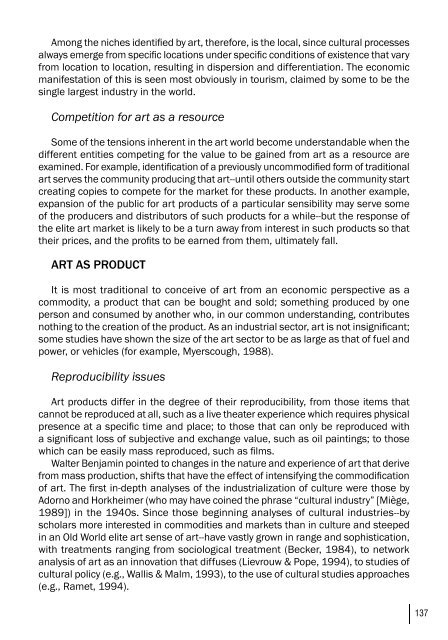art-e-conomy _ reader - marko stamenkovic
art-e-conomy _ reader - marko stamenkovic
art-e-conomy _ reader - marko stamenkovic
Create successful ePaper yourself
Turn your PDF publications into a flip-book with our unique Google optimized e-Paper software.
Among the niches identified by <strong>art</strong>, therefore, is the local, since cultural processes<br />
always emerge from specific locations under specific conditions of existence that vary<br />
from location to location, resulting in dispersion and differentiation. The economic<br />
manifestation of this is seen most obviously in tourism, claimed by some to be the<br />
single largest industry in the world.<br />
Competition for <strong>art</strong> as a resource<br />
Some of the tensions inherent in the <strong>art</strong> world become understandable when the<br />
different entities competing for the value to be gained from <strong>art</strong> as a resource are<br />
examined. For example, identification of a previously uncommodified form of traditional<br />
<strong>art</strong> serves the community producing that <strong>art</strong>--until others outside the community st<strong>art</strong><br />
creating copies to compete for the market for these products. In another example,<br />
expansion of the public for <strong>art</strong> products of a p<strong>art</strong>icular sensibility may serve some<br />
of the producers and distributors of such products for a while--but the response of<br />
the elite <strong>art</strong> market is likely to be a turn away from interest in such products so that<br />
their prices, and the profits to be earned from them, ultimately fall.<br />
ART AS PRODUCT<br />
It is most traditional to conceive of <strong>art</strong> from an economic perspective as a<br />
commodity, a product that can be bought and sold; something produced by one<br />
person and consumed by another who, in our common understanding, contributes<br />
nothing to the creation of the product. As an industrial sector, <strong>art</strong> is not insignificant;<br />
some studies have shown the size of the <strong>art</strong> sector to be as large as that of fuel and<br />
power, or vehicles (for example, Myerscough, 1988).<br />
Reproducibility issues<br />
Art products differ in the degree of their reproducibility, from those items that<br />
cannot be reproduced at all, such as a live theater experience which requires physical<br />
presence at a specific time and place; to those that can only be reproduced with<br />
a significant loss of subjective and exchange value, such as oil paintings; to those<br />
which can be easily mass reproduced, such as films.<br />
Walter Benjamin pointed to changes in the nature and experience of <strong>art</strong> that derive<br />
from mass production, shifts that have the effect of intensifying the commodification<br />
of <strong>art</strong>. The first in-depth analyses of the industrialization of culture were those by<br />
Adorno and Horkheimer (who may have coined the phrase “cultural industry” [Miège,<br />
1989]) in the 1940s. Since those beginning analyses of cultural industries--by<br />
scholars more interested in commodities and markets than in culture and steeped<br />
in an Old World elite <strong>art</strong> sense of <strong>art</strong>--have vastly grown in range and sophistication,<br />
with treatments ranging from sociological treatment (Becker, 1984), to network<br />
analysis of <strong>art</strong> as an innovation that diffuses (Lievrouw & Pope, 1994), to studies of<br />
cultural policy (e.g., Wallis & Malm, 1993), to the use of cultural studies approaches<br />
(e.g., Ramet, 1994).<br />
137


